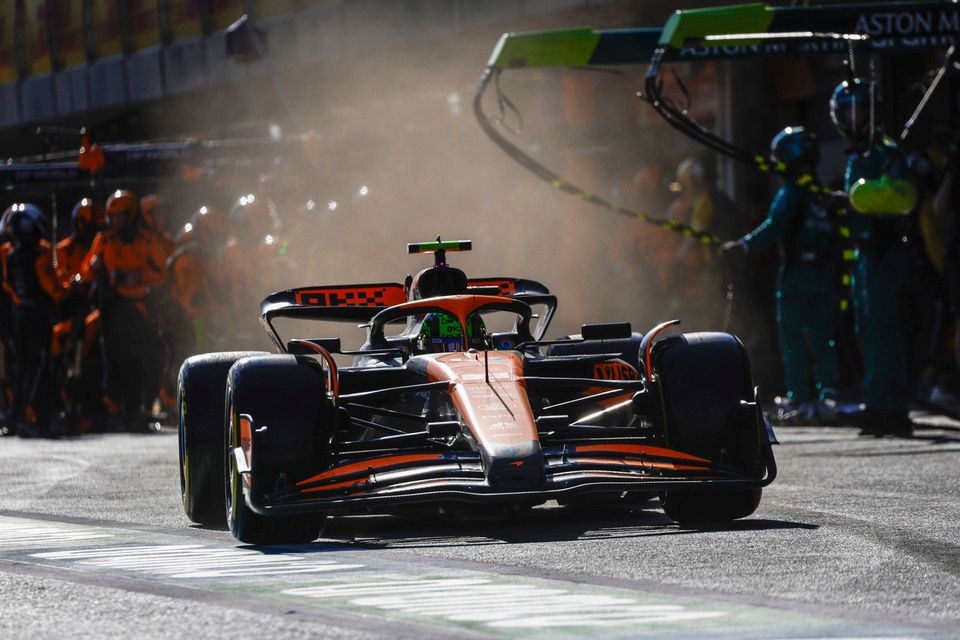
The FIA is pondering whether to take action about potential flexing rear wings in Formula 1 in the wake of the controversy caused by McLaren’s ‘mini-DRS.’
The behaviour of the McLaren rear wing at last weekend’s Azerbaijan Grand Prix came under the spotlight after footage of its behaviour emerged from television coverage of its rearward facing onboard camera.
The top element of the rear wing was observed to rotate back at speed on the straights, and appeared to be designed in such a way that this change in attitude opened up the slot gap.
This will help reduce drag and boost top speed, and it quickly earned the nickname of being like a ‘mini-DRS.’
The McLaren design immediately came under the spotlight from rival squads and it prompted some calls for clarification about what is and is not allowed in terms of the flexibility of rear wings.
Ahead of this weekend’s Singapore Grand Prix, motor racing’s governing body has revealed it is now reviewing evidence it has gathered from Baku to decide if any action needs to be taken.
A statement from the FIA said: “The FIA is closely monitoring the flexibility of bodywork on all cars and reserves the right to request teams to make modifications at any point during the season.

“However, if a team successfully passes all deflection tests and adheres to the regulations and technical directives, they are deemed to be in full compliance, and no further action will be taken.
“The FIA is currently reviewing data and any additional evidence that has emerged from the Baku GP and is considering any mitigating measures for future implementation.
“This is part of the standard process when scrutineering technical legality, and the FIA retains the authority to introduce regulatory changes during the season if required.”
With the McLaren rear wing having passed the mandatory deflection tests in the pit lane, there is no question that it fully conforms to the current regulations.
However, the debate is about whether deliberately designing a wing to flex in the manner it does goes against FIA guidance in terms of what is deemed to be acceptable flexing.
In a still current technical directive (TD34) from the FIA that offers guidelines on flexing wings, it is made that clear that certain behaviours will not be tolerated even if wings are passed as legal in the pits.
PLUS: How F1 moved away from subjective scrutineering on issues of flexing
In the note, the FIA says that it does not consider legal “designs whose structural characteristics are altered by secondary parameters, so as to produce (whilst running at the track) a different deflection characteristic than when stationary during the FIA checks. Examples of secondary parameters could be temperature, aerodynamic load etc.”
Rival team bosses are keeping a close eye on the McLaren developments, amid a push for greater clarity on what is deemed to be acceptable.

One team boss told Autosport: “Aero elasticity has been a factor for many, many years now, and even if a wing passes the FIA test the regulations remain very clear - the component cannot be designed to flex.
“We rely on the FIA to say, okay, what are the boundaries of that? Of course, everything will flex to a certain degree, but what is acceptable and what is not?
“We're starting to see extremities be exploited again, and I think it's down to the FIA to decide, is that okay, in which case everybody will pile in or, as per the regulation, the way it's written, does that comply?
“There is a large scatter of who's doing what now, obviously with a lot of interest in the McLaren rear wing after Baku and there is performance in it – of course there is.
“That is why everyone is chasing it. But it's just knowing what is reasonable, and what's taking the piss.”
But while McLaren is at the centre of the current intrigue, it is understood to not be the only team whose rear wing design is coming under the spotlight because of either flexing on the straight of the opening of the slot gap.
McLaren's rear wing was covered up as the car was being assembled in the Singapore pit lane on Thursday, but this is understood to be related to a new livery launch taking place later in the day.
Watch: McLaren In Charge - F1 Azerbaijan GP Analysis







